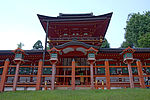Draft:Ame-no-Oshikumone
| This is a draft article. It is a work in progress open to editing by anyone. Please ensure core content policies are met before publishing it as a live Wikipedia article. Find sources: Google (books · news · scholar · free images · WP refs) · FENS · JSTOR · TWL Last edited by Immanuelle (talk | contribs) 5 months ago. (Update)
Finished drafting? or |
| Personal information | |
|---|---|
| Parents |
|
Ame-no-Oshikumone is a Japanese deity and the Oyagami of the Nakatomi clan.
He is in a famous painting.[3]
He was associated with Susanoo-no-Mikoto and the Izumo Province.
He is a component of Kasuga no Kami[4]. He was added much later than the rest of them andis said to be the divine child of Ame no koyane and Himegami.[5] The importance of the multifaceted kami was that it became a template for future worshipers who wanted to combine several deities to pray to at once.[6]
Content taken from Himegami[edit]
The Kasuga-Hiraoka Himegami is a prominent one.[7][8]
Hiraoka Shrine is located in the western foothills of the Ikoma Mountains in central Osaka Prefecture. In its earliest days, it was a center for mountain worship and the kami of Kozudake, the peak immediately behind the shrine, came to be identified with Ame-no-Koyane, the tutelary deity of the Nakatomi clan, the ancestors of the Fujiwara clan. There is no documentary evidence of when the shrine was first constructed, but it is believed to be sometime during the Kofun period. When the Fujiwara built Kasuga Taisha in Nara, two of the four kami enshrined (Ame-no-Koyomi and Himegami) were bunrei transferred from this shrine, and the Hiraoka Shrine was thus given the name of Moto-Kasuga ("former Kasuga").[7][8]
The four main kami enshrined at Kasuga-taisha are Ame no koyane, Himegami, Futsunushi no mikoto, and Takemikazuchi no mikoto.[9] Though these are the primary divine beings of Kasuga taisha, they are often grouped together as a syncretic, combined deity known as Kasuga Daimyōjin.[4] Kasuga Daimyōjin is composed of five divine beings and each consists of a Buddhist deity and Shinto kami counterpart. The fifth deity, Ame-no-Oshikumone, was added much later and is said to be the divine child of Ame no koyane and Himegami.[5] The importance of the multifaceted kami was that it became a template for future worshipers who wanted to combine several deities to pray to at once.[6]
The four main kami each have a shrine devoted to them which are all in the same architectural style. They are characterized by sloping gabled roofs, a rectangular structure, katsuogi (decorative logs), and chigi (forked roof structures).[10] The first hall established is dedicated to Takemikazuchi no mikoto, the second to Futsunushi no mikoto, the third to Amenokoyane no mikoto, and the final hall is attributed to the consort, Himegami.[11]
References[edit]
- ^ Shibata, Joue. Saitama Sōsho. (1929) Volume 1: Chichibu Shi, p 111, Chichibu hikomikoto o keizu 『埼玉叢書. 第1巻』内『秩父志』内111頁「秩父彦命御系図」. Sanmeisha
- ^ Shibata, Joue. Saitama Sōsho. (1929) Volume 1: Chichibu Shi, p 111, Chichibu hikomikoto o keizu 『埼玉叢書. 第1巻』内『秩父志』内111頁「秩父彦命御系図」. Sanmeisha
- ^ "Mandala of Wakamiya of Kasuga Shrine (Kasuga wakamiya mandara) | Japan | Nanbokuchō period (1336–92)". The Metropolitan Museum of Art. Retrieved 2023-12-02.
- ^ a b Tyler, Royall (2016). The miracles of the Kasuga deity. Columbia University Press. ISBN 9780231534765. OCLC 954193203.
- ^ a b Ten Grotenhuis, Elizabeth (1999). Japanese mandalas : representations of sacred geography. University of Hawai'i Press. ISBN 0824820002. OCLC 39181008.
- ^ a b Ashkenazi, Michael (2011). Handbook of Japanese mythology. ABC-CLIO. ISBN 9781849728560. OCLC 755870995.
- ^ a b Yoshiki, Emi (2007). Zenkoku 'Ichinomiya' tettei gaido (in Japanese). PHP Institute. ISBN 978-4569669304.
- ^ a b Okada, Shoji (2014). Taiyō no chizuchō 24 zenkoku 'Ichinomiya' meguri (in Japanese). Heibonsha. ISBN 978-4582945614.
- ^ Grapard, Allan G. (1992). The protocol of the gods: a study of the Kasuga cult in Japanese history. University of California Press. ISBN 0520070976. OCLC 25873140.
- ^ Cali, Joseph (2013). Shinto shrines: a guide to the sacred sites of Japan's ancient religion. University of Hawai'i Press. ISBN 9780824837136. OCLC 1043096844.
- ^ "Main Sanctuary". www.kasugataisha.or.jp. Archived from the original on 2019-06-24. Retrieved 2019-03-28.

